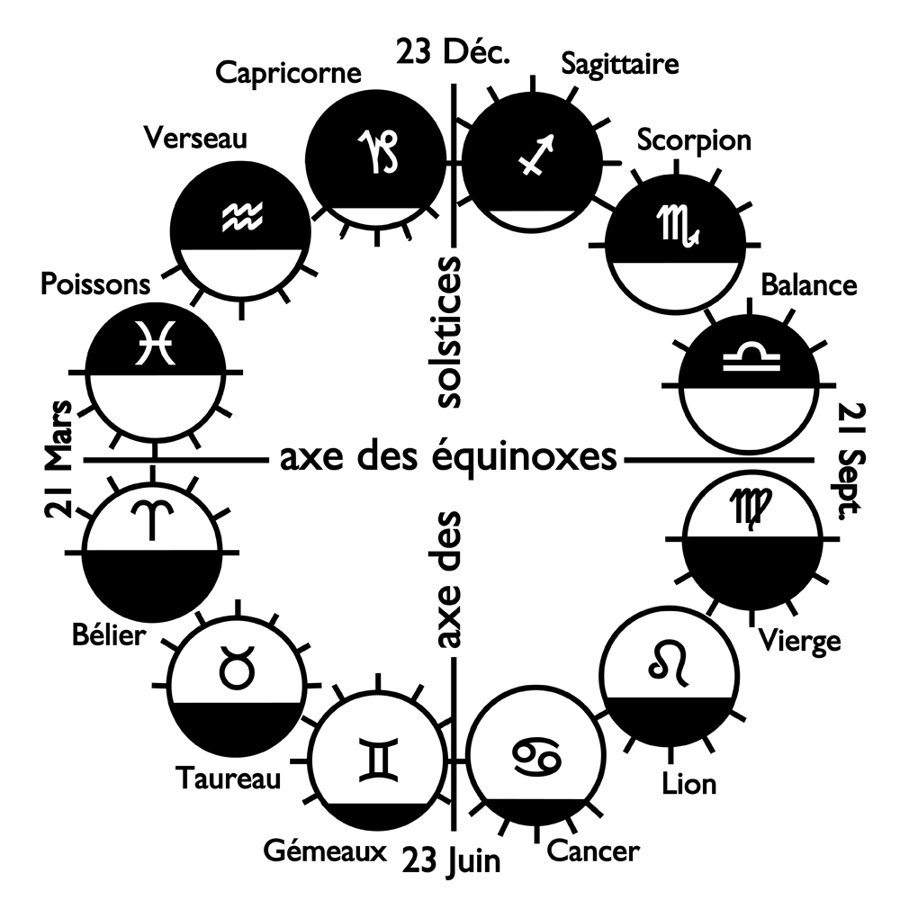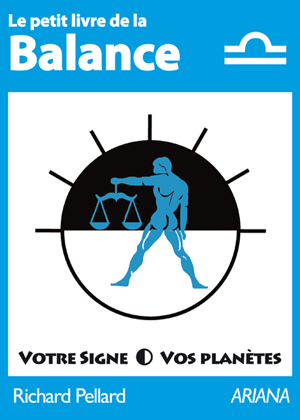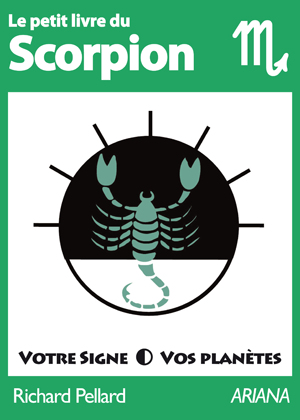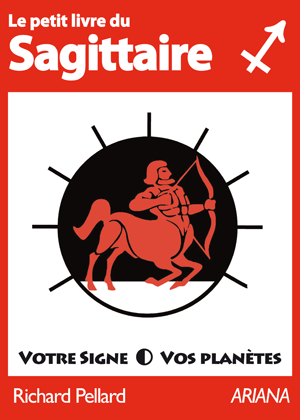Your Planets
Portraits of the Planets
Aspects between Planets
The planetary ages
The planetary families
Planets in Signs
The Planets in comics


Far from being an archaic myth or a disembodied symbol, the zodiac is as real as day, night and their durations which change periodically throughout the year. To be born under the sign of Libra, for example, is not to look like a scale, it is to have come to Earth at the time of the autumnal equinox, when the Sun began its descent in the hemisphere. south and that the length of days and nights was balanced again (12 hours each), which had not happened since the vernal equinox six months earlier.
It is in an improper but practical way that we evoke the Signs of Spring, of Summer, of Autumn and Winter. Indeed, the seasons only exist for the Sun. For example, while the Sun is in Gemini, Venus can very well be in Cancer. The diagram above describes the growth of the dominant night in duration (for the Sun) or day arcs (for the Moon and the planets) from the autumnal equinox to the winter solstice (from the equator to the tropic of Capricorn).
 At the autumnal equinox, the Sun leaves the northern hemisphere, crosses the plane of the equator and plunges into the southern hemisphere. From now on, until the next spring equinox, in the northern hemisphere the nights will be systematically longer than the days. In Libra (September 23 to October 23), the diurnal and nocturnal durations are substantially equal, but the nocturnal ones are increasing: they are dominant. In Scorpio (October 23 to November 22), nocturnal durations are significantly greater than diurnal ones. Finally, in Sagittarius (November 22 to December 22), the ever-increasing nocturnal durations are clearly greater than the nocturnal ones: the longest night is not far away…
At the autumnal equinox, the Sun leaves the northern hemisphere, crosses the plane of the equator and plunges into the southern hemisphere. From now on, until the next spring equinox, in the northern hemisphere the nights will be systematically longer than the days. In Libra (September 23 to October 23), the diurnal and nocturnal durations are substantially equal, but the nocturnal ones are increasing: they are dominant. In Scorpio (October 23 to November 22), nocturnal durations are significantly greater than diurnal ones. Finally, in Sagittarius (November 22 to December 22), the ever-increasing nocturnal durations are clearly greater than the nocturnal ones: the longest night is not far away…
The dominant days in duration, as we have seen, are for living beings a factor of excitement, of openness to the outside world. During the six months of autumn and winter, the reign of the dominant nights will on the contrary induce reactions of inhibition, retraction, closure. Completely official observations and experiments have also shown that people suffering from seasonal depression see their condition improve markedly when they change the terrestrial hemisphere or when they are subjected to “photoperiod therapies”, that is to say when they were placed in a room whose artificial lighting reproduced increasing and dominant diurnal durations…
Let us take advantage of these observations on the increase or decrease of days and nights to briefly evoke Christian symbolism. Let us recall in passing that Christianity is an outgrowth of Judaism, and that the Jewish religion is the direct heir of the Mesopotamian religion, whose foundations rested on astronomy and astrology… If modern Christianity has totally denied its cosmic ties concrete, the solar myths on which it is based die hard…
Saint John the Baptist is celebrated at the time of the summer solstice. At this time of the year, that of the longest day, the days begin to decrease in length, while that of the nights increases. Saint John was a prophet who announced the coming of Christ and baptized his contemporaries to prepare them for the advent of the expected Messiah. When asked about his role and function in this process, he answered with humility: “He must increase and I must decrease.” In a very symbolic way, the daytime influence of Saint John diminished while the nocturnal influence of the still latent Christ grew.
The legend gave birth to Christ at the winter solstice, at the moment when humanity is plunged into the longest night… but also at the moment when the growing day begins to nibble the territory of darkness, like a promise of dawn. which will only be realized at the vernal equinox, under the sign of Aries. Thus the mythical Christ governs the growth of the light of day, and symbolizes a growing light.
In fact, Christ was not born under the Sign of Capricorn. The church decided to give birth to him at that time to substitute his own feast for the ancient pagan feasts which marked the equinoxes and the solstices… and for unconscious astronomical-astrological reasons: Jesus is likened to a growing light (and invites us to believe) in the longest night! It should be noted that the astral chart of Christ is unknown, but that the documents of the time rather suggest a birth in early spring. The energetic Jesus would therefore have been born under the sign of Aries, which corresponds well to the author of the famous phrase: “He who is not with me is against me”…
Taken as a whole, the three Signs of Autumn are characterized by their expansive dynamism and the rapidity of their closing reflexes. The other side of the coin: it is difficult for them to be patient and persevering…
Strong points: if the Signs of Autumn are dominant in your chart, an important part of yourself is expressing itself in an extremely lively, rapid, mobile way. Always available to the outside world, you also master the art of dodging to the highest degree, ready to resign suddenly if circumstances require it. Your subtle defensive tactics allow you to turn around at full speed, to alternate wide openings and immediate refusals with great ease.
Weak points: you generally find it difficult to control and regulate your energy, to be constant and systematic in your efforts. Everything that is ritual, repetitive, systematic annoys you. Too confident in your tactical flexibility, you too often forget to organize yourself to protect yourself from the unexpected. When you make a mistake, you tend to persist in the error as you have the impression that whatever happens, you are able to dominate and master the situation.
Astronomy: increasing and dominant nights, nocturnal durations substantially equal to diurnal ones.
Astrology: strong points: dynamic openness, swift closedness, sense of opposites. Weak points: lack of systematic closedness, of restrained openness, egalitarian phase.
Strengths: fast, flexible and skilful, the Libra sets out to meet the outside world and the beings that inhabit it. For her, everything is a question of choice in an open universe: the choice to cooperate or to escape, to go towards others or to leave them suddenly. Libra absents herself from herself to make herself available to others whom she considers an equal and a partner with whom we must seek a balanced relationship, common points, common ground that allows everyone to get out of its shell…
Weaknesses: too open to the outside world, Libra sins for lack of limits and refusal of borders. She does not understand the need to protect herself, to isolate herself, to patiently build security systems. Refusing differences, she sees similarities everywhere, echoes, resemblances even where there are none and, whatever the circumstances, persists in her illusory quest for a universal balance. By dint of wanting to get on well with everyone, she often forgets to be herself.
Astronomy: nil.
Astrology: Sign of Air Cardinal, Hot and Humid. The Air of Libra is Cardinal: it therefore decides where the wind should blow and directs the air currents. Venus, her master planet, is rather Hot and Humid, which is good, but in reality, it is Hot and dry: (up to 457° of temperature on the ground). In the humid heat of desire, the Venusian Libra is a seductress in search of a partner.

Astronomy: increasing and dominant nights, nocturnal durations significantly longer than diurnal ones.
Astrology: strong points: focused and very mobile closedness, sense of proportions. Weak points: lack of beaming and persistent openness, paradoxical phase.
Strengths: subtle, cunning and sinuous, the Scorpio is very selective and discriminating in its openness to the outside world: only what excites it interests it, the rest provokes in it reactions of rejection and criticism. Obsessive, he is in search of precise adjustments, close associations, tight bonds. Where others see similarities and complementarities, he immediately identifies differences and oppositions. Its flexible defense mechanisms push it to zigzag between obstacles rather than confronting them directly.
Weaknesses: locked in his “difference” that he proudly claims, Scorpio tends to stagnate, to get bogged down, prisoner of himself, of his intolerances and his refusals. Too subtle, it weaves cobwebs where it gets stuck. The more he feels rejected and misunderstood, the more he persists in his attitudes of rejection, convinced that this is his only way to reign over himself. Innuendoes and trivial details are enough to arouse his susceptibility. Chronically recalcitrant, he tends to dramatize, to overly darken the picture.
Astronomy: nil.
Astrology: Sign of Water Fixed, Cold and Wet. Scorpion Water is Fixed: hence its taste for stagnant marshes and its tendency to drink the chalice to the dregs in a closed vessel. Her master planet is Mars, Hot and Dry (in reality, the maximum temperature on this planet is 0°). Thanks to his sense of subtle dosages, he manages to blow both Hot and Cold. Did he coin the term “drink dry” ? Not possible…

Astronomy: increasing and dominant nights, nocturnal durations clearly superior to nocturnal ones.
Astrology: strong points: dynamic openness, swift closedness, sense of syntheses. Weak points: lack of systematic closedness, of restrained openness, ultraparadoxical phase.
Strengths: wide open to the outside world, the Sagittarius considers the universe that surrounds it as a dynamic totality of which it is an intimate part and with which it is necessary to cooperate to the maximum. Skillful unifier, flexible negotiator, he constantly seeks the greatest common denominator, the broadest agreement, the overcoming of the usual oppositions in a moving synthesis; but he also knows how to say quickly “no”, to resign surreptitiously or to slip away gently when necessary…
Weaknesses: refusing any constraint, any protection, any reassuring attachment, Sagittarius sees too big. Excessive, disproportionate, sometimes megalomaniac, he hugs badly because he wants to embrace everything and mixes everything up because he wants to bring everything together. He forgets the difference between good and evil, friend and foe, himself and others. Having deserted his intimacy, fleeing the banal and the cramped daily life, he indulges in an intoxicating headlong rush in search of the sublime, with an unfortunate tendency to fight windmills.
Astronomy: nil.
Astrology: sign of Fire Mutable, Hot and Dry. The Fire of Sagittarius is Mutable: hence its tendency to burn its last planks before dying out. Her master planet is Jupiter, a planet of hot and humid air (in reality, the average temperature of Jupiter is −140° and this planet is essentially made up of hydrogen). Both hot, Jupiter and Sagittarius communicate in passion. The negotiating skills of the first and the sense of the sets of the second make it possible to achieve the synthesis of the Dry and the Wet (???).

▶ Your zodiac Sign
▶ Signs and seasons
▶ Planetary trios in Signs
▶ The zodiac and the precession of the equinoxes
▶ The astronomical reality of the zodiac
▶ The human reflexology zodiac
▶ Autour du zodiaque : de l’eau dans un Signe de Feu ?
▶ Zodiaque et sphère locale
▶ Mythologie du zodiaque
▶ Zodiaque et formes de l’inhibition
▶ Change-t-on de caractère en changeant de Signe solaire ?
▶ Énergie-Espace-Temps-Structure et zodiaque
▶ Genèse du zodiaque conditionaliste
▶ L’horloge photopériodique du genou
▶ Signe solaire et Signe Ascendant
▶ Astrologie, adaptation & inadaptation

Le petit livre de la Balance
par
49 pages. Illustrations en couleur.
Ce livre présente et explique les trois zodiaques : celui du décor des constellations, celui de l’astrologie traditionnelle basé sur les Quatre Éléments symboliques (Feu, Terre, Air & Eau) et celui de l’astrologie naturelle basé sur les phénomènes astronomiques objectifs.
Interprétation de la Balance selon la symbolique classique et selon ses réflexes dans le zodiaque naturel (force, vitesse, équilibre) ; interprétation de la Balance en fonction des planètes dominantes ; le Signe solaire & le Signe Ascendant.
Téléchargez-le dès maintenant dans notre boutique

Le petit livre du Scorpion
par
49 pages. Illustrations en couleur.
Ce livre présente et explique les trois zodiaques : celui du décor des constellations, celui de l’astrologie traditionnelle basé sur les Quatre Éléments symboliques (Feu, Terre, Air & Eau) et celui de l’astrologie naturelle basé sur les phénomènes astronomiques objectifs.
Interprétation du Scorpion selon la symbolique classique et selon ses réflexes dans le zodiaque naturel (force, vitesse, équilibre) ; interprétation du Scorpion en fonction des planètes dominantes ; le Signe solaire & le Signe Ascendant.
Téléchargez-le dès maintenant dans notre boutique

Le petit livre du Sagittaire
par
49 pages. Illustrations en couleur.
Ce livre présente et explique les trois zodiaques : celui du décor des constellations, celui de l’astrologie traditionnelle basé sur les Quatre Éléments symboliques (Feu, Terre, Air & Eau) et celui de l’astrologie naturelle basé sur les phénomènes astronomiques objectifs.
Interprétation du Sagittaire selon la symbolique classique et selon ses réflexes dans le zodiaque naturel (force, vitesse, équilibre) ; interprétation du Sagittaire en fonction des planètes dominantes ; le Signe solaire & le Signe Ascendant.
Téléchargez-le dès maintenant dans notre boutique